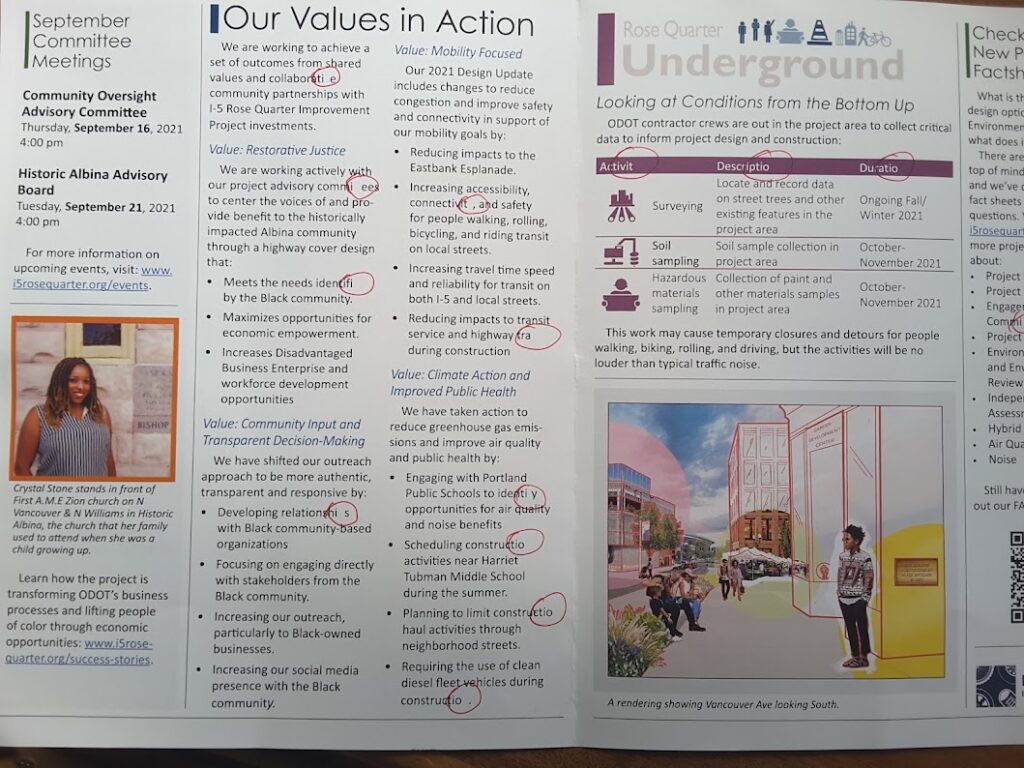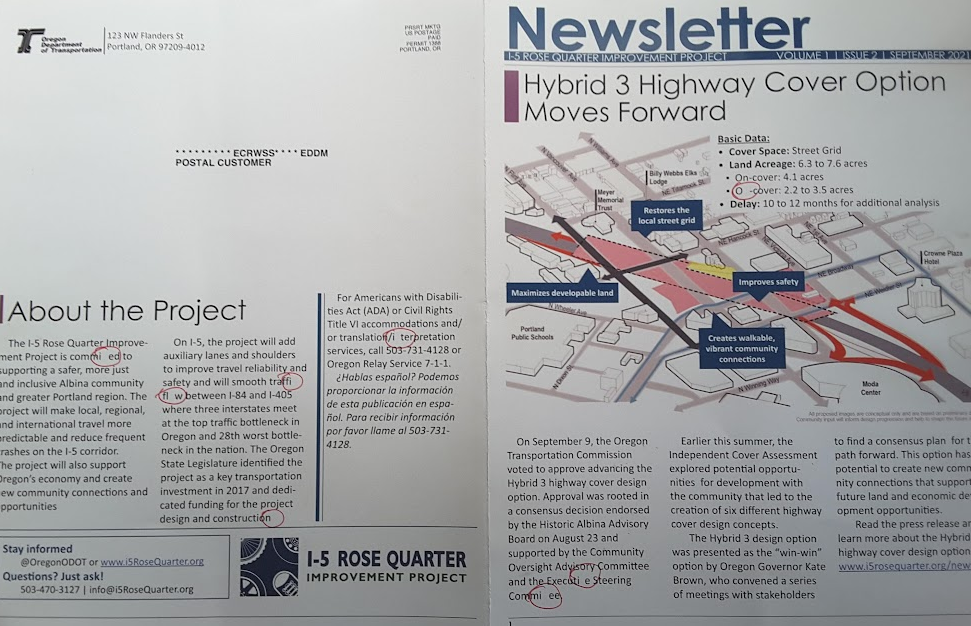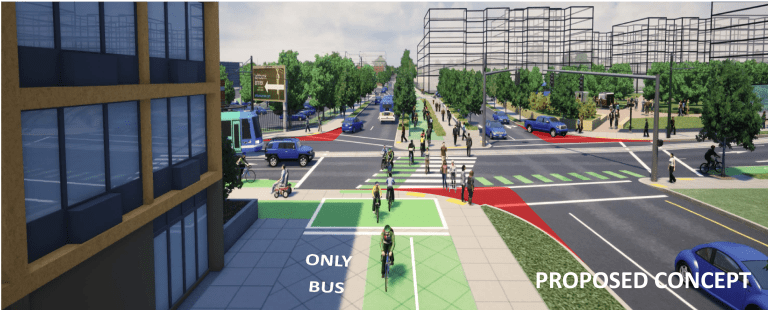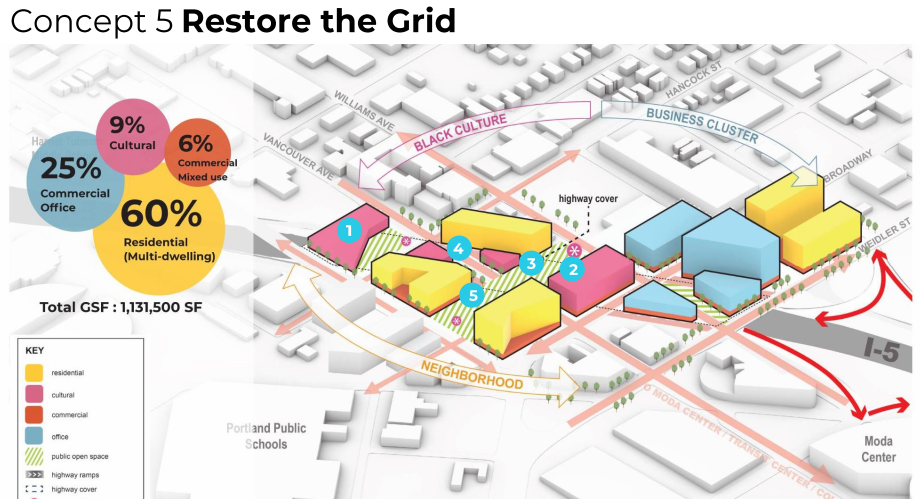The Oregon Department of Transportation’s glossy mailer to sell its $1.25 billion I-5 Rose Quarter Freeway widening project is a cynical, error-ridden marketing ploy.
ODOT doesn’t show or tell about its wider freeway and more traffic, but instead tries to sell the project based on buildings it won’t contribute any money for building.
ODOT sent an expensive mailer to thousands of Portland households studded with nearly two-dozen typographical errors.
The key part of salesmanship, whether you’re selling condominium time-shares or breakfast cereal, is to emphasize the really attractive things that aren’t part of what the customer is paying for, whether it’s models cavorting on a glistening white-sand beach or the fresh bananas and blueberries atop a pile of bland corn-flakes. The grifters at the Oregon Department of Transportation have settled on just this strategy for peddling their now $1.25 billion Rose Quarter freeway widening project. In their latest marketing material: It’s not about cars or lanes at all, it’s about covers and community centers and housing built by Black artisans. Never mind that these “features”—like the models and the blueberries—aren’t actually part of the ODOT project at all.
Woke-washing: Fictional buildings
As we’ve documented at City Observatory, the Oregon Department of Transportation is implicated in the destruction of Portland’s historically Black Albina neighborhood. It slashed through the area with three major highway projects in the 1950s, 1960s and 1970s, leading to a two-thirds decline in neighborhood population. Today, its trying to sell its massive 10-lane wide freeway widening project—which would increase traffic and pollution—as a way to remediate the damage to the neighborhood.
Earlier this month, ODOT sent a glossy 4-page newsletter to thousands of Portland households. Its key feature is illustrations portraying new, but entirely fictitious, buildings lining the streets of Albina. Previously, they’ve shown proposed buildings to be constructed on or adjacent to the freeway as part of the project’s environmental assessment. Earlier this year, they paid consultants to illustrate hundreds of entirely conjectural apartments on or next to the widened freeway. Now their new brochure sets a new bar for illusion, showing a fictitious streetscape of N. Vancouver Avenue, with three imaginary buildings. In the lower right hand side of the frame, a young Black man stands in front of a building labeled a “Career Development Center,” carrying a plaque stating: “This building constructed by Black artisans in 2022.” It’s a nice thought, but such a building is not part of what ODOT will build or pay for. Nor, in fact, are any of these buildings.
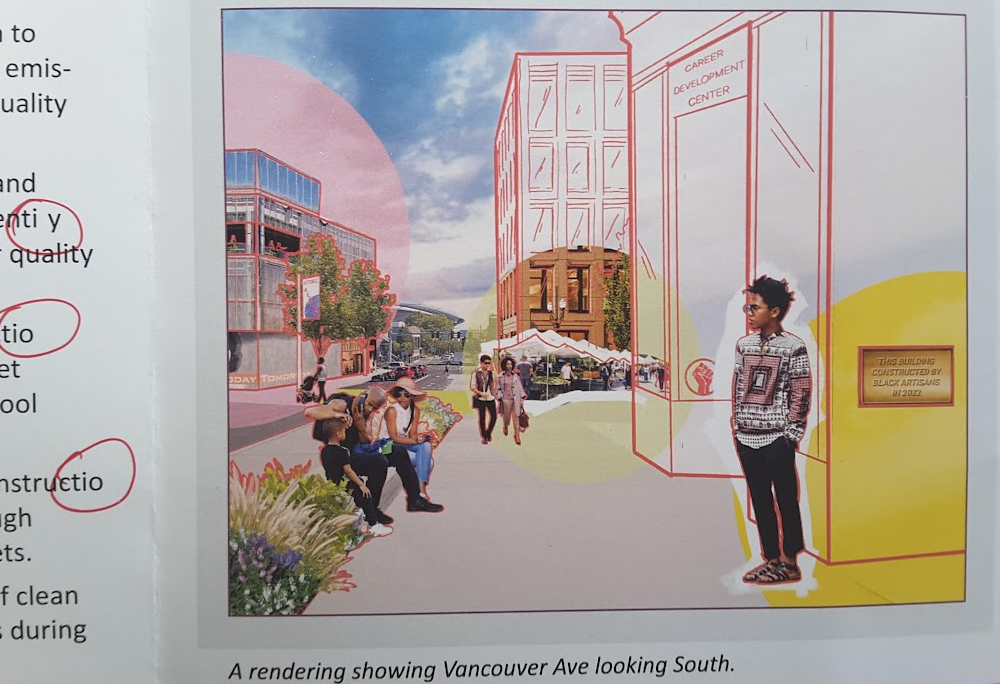
If this were a commercial publication, it would have to include some kind of disclaimer. ODOT went out of its way to emphasize the “highway cover” aspects of the project, without mentioning that the project’s real purpose is to widen the freeway. The brochure is doesn’t show a single car, nor does it reveal that the project is designed to expand the freeway to as much as ten lanes wide.
Fraud: There’s no money to build these buildings
It would, of course, be nice to have more housing in Albina, and to have a career development center, and to advance the redevelopment plans of the Albina Vision Trust. But in reality, none of these features is actually part of ODOT’s I-5 Rose Quarter Freeway widening project.
The fundamental problem with all these imaginary buildings, including new housing, and the career development center: There’s no funding for any of them as part of the Rose Quarter freeway widening project. And, as we’ve shown at City Observatory, the cost of new buildings shown would run to hundreds of millions of dollars. Despite the fact that it demolished hundreds of homes to build its highways through Albina, ODOT has never provided a dime to rebuild any of them, and is saying it won’t as part of this project either.
At best, the project claims that it might provide the sites on which these mythical structures could be built, but even that claim is misleading. The Oregon Transportation Commission is now seeking to stick city and county governments with the added costs of freeway covers wide and strong enough to support this development. So while apartments and a career development center are being prominently displayed as the centerpiece of this project, ODOT isn’t paying for any of them, or even the sites on which they’ll be built. They expect others to do so. The fact that the agency pretends to care about social justice, but won’t contribute to repairing the damage its three highways caused Albina, including replacing the housing it destroyed, shows its commitment is a sham.
Incompetence: A document shot-through with typographical errors
The full-color glossy four-page brochure, titled “Newsletter: I-5 Rose Quarter Improvement Project, Volume 1, Issue 2, September 2021” was delivered via bulk mail to thousands of households in North and Northeast Portland. But while ODOT took great pains to downplay the actual nature of the project (a ten-lane freeway), and to incorporate images of African-Americans and fictitious buildings, they apparently didn’t have a budget for proof-reading or care enough to do a press check of their elaborate newsletter.
As publishers ourselves, we know that the occasional typo is the bane of one’s existence, and that a few always seem to sneak through. No one is perfect. But in this ODOT newsletter we counted 23 typographical errors. Here we’ve circled in red errors on pages 2-3 of the brochure.
There were errors on every page of the brochure. One page of the report is titled: “Our Values in Action.” Apparently neither accuracy nor attention to detail are among the project’s values. For years, the agency has been misleading the public about the project, concealing basic facts like the width of the freeway it is planning to build and repeatedly including illustrations of fictional buildings that aren’t part of the project (see below).
There’s a lot of missing substance in this ODOT newsletter. It reveals nothing about the cost of the project, which has ballooned to $1.25 billion. It conceals the fact that the real purpose of the project is to widen the I-5 freeway to 10 lanes, which will result in more traffic and pollution. It ignores news reports that have utterly disproven its false safety claims about the project. It says nothing about the active community opposition to the project, which has produced thousands of citizen objections. It doesn’t reveal that the project is being challenged in court for violating federal environmental laws and state planning requirements. It fails to acknowledge that the project will increase greenhouse gases–a fact that has produced regular bi-weekly protests at ODOT’s Portland headquarters.
What this document really shows is that ODOT has no intention of telling the truth about the Rose Quarter freeway widening project. This brochure, like the ODOT effort that produced it, is cynical, misleading and incompetent. This is hardly an effort that should be rewarded with $1.25 billion in public funds.
ODOT’s deceptive history
Here are illustrations from the project’s 2019 Environmental Assessment showing wireframe buildings as part of the freeway-widening concept. (Again: There’s no funding for such buildings as part of the project).
Likewise, ODOT’s highway cover consultants created the illusion that apartment buildings (the yellow legos on this diagram) might be part of the project’s covers. Building such apartments would cost between $160 million and $250 million, and ODOT is providing no funding for any such construction.

